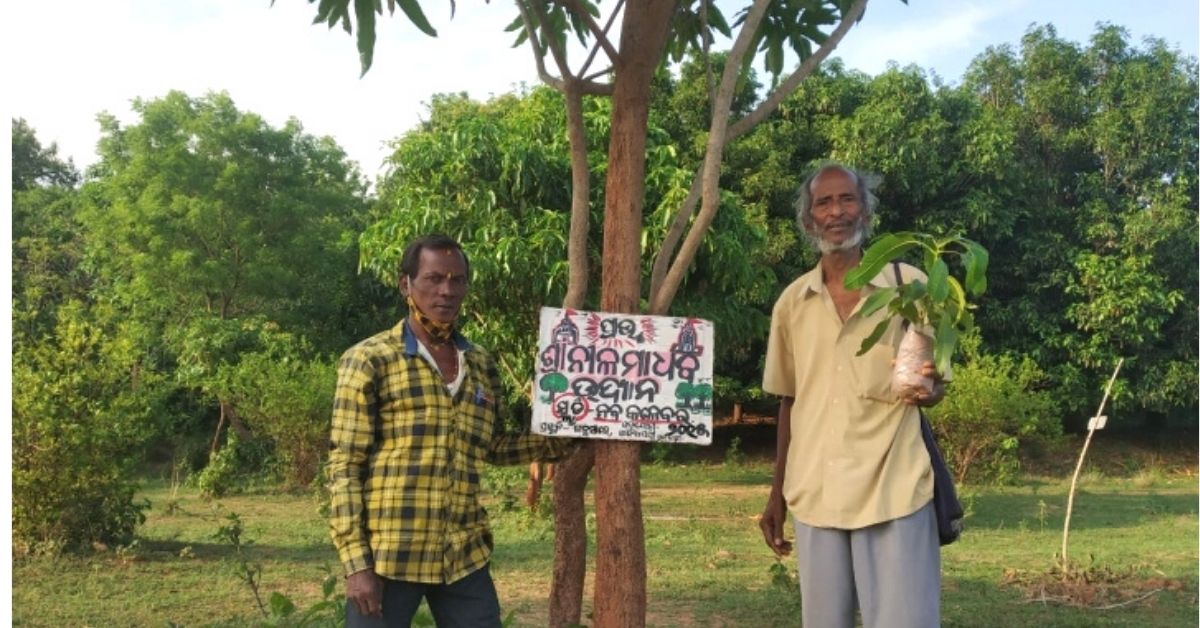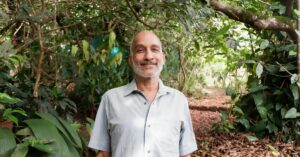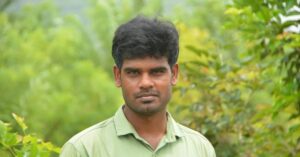30,000 Trees, 1 Man: Meet Odisha’s Incredible 75-Year-Old ‘Tree Teacher’
Antaryami Sahoo from Odisha, also known as Gaccha sir, is on a mission to conserve the environment and wildlife by planting thousands of trees in public spaces, alongside creating awareness through handmade posters

Antaryami Sahoo from Kantilo village in Odisha was barely 11 years old when he planted a banyan sapling on his school premises. This was not part of a plantation drive, but an individual effort born out of his love for trees and the environment.
Since then, every year, he has planted a couple of trees in public spaces around his village. His love for trees grew with age, and when he joined as a teacher in Siletpada UP school, he began encouraging children there to follow suit.
During his tenure as a teacher, Antaryami planted thousands of trees in school backyards, public spaces around villages in Boudh district, on barren lands, and on the roadside. Alongside, he also spread awareness about wildlife conservation among the village residents. His work over the years has earned him the name Gachha sir, which means ‘tree’ in Odiya.
Antaryami is now 75 years old, but works with the same grit and passion to conserve the environment.
Labour of love

“I joined the school as a primary teacher in 1973 and have since carried massive plantation drives across six schools, where I was transferred one after the other as part of the administrative process. I used to source a few saplings from the forest department and create a nursery from the seedlings as well,” he tells The Better India.
Antaryami says that his work continued until 2004 when he individually planted 10,000 trees, as well as 20,000 more with students. He emphasised planting saplings such as sal, teak, banyan, mango, Indian beal, fig and other native species. He continues to plant trees even today, and has planted over 30,000 trees now, which have been documented area wise. “I also collect and distribute seeds,” he adds.
But as Antaryami worked more for the cause, he realised that increasing greenery alone would not solve the deteriorating state of the environment. There were multiple forest fires still being reported in the region.
“Along with increasing green cover, it is imperative to protect the existing forests and trees. I learned that a majority of forest fires were attributed to the poachers, as they lit them to hunt small animals in a patch. But the flames became uncontrollable and spread, posing a threat to the forest and wildlife at large,” he says.
With no social media or means to create awareness among people, Antaryami started making handmade posters with drawings of animals, trees and writing bullet points to emphasise the importance of saving them.
“People often think that planting trees will solve the environmental crisis. But protecting biodiversity and wildlife is equally important. I identified and made posters of about 40 local species such as honey bees, pangolin, owl, deer, elephant, butterflies, lizards, bats, grasshoppers, dragonfly, ladybug and birds. The handmade posters served two purposes – they were interactive and helped sensitise the population, and I could highlight the negative impact on as well as benefits of the particular tree, animal or biodiversity,” he says.
Explaining the content of his posters, Antaryami says, “I inform locals about how over plucking flowers can deprive honey bees of nectar and affect their population. No life can exist without honey bees. Also, people hold parrots captive for trade. I ran a campaign ‘Not To Be Caged’ to argue against this.”

Witnessing large-scale deforestation, Antaryami says he planted trees such as date, palm and others that serve as a safe habitat for birds and insects. “People mainly focus on big and exotic animals, and there are very few that care about insects, birds and wildlife,” he shares.
He stresses that every species, including humans, depends on each other for survival. “It is significant to protect their habitat and ensure their existence to enable their ecological role in the environment,” Antaryami adds.
Antaryami says his efforts helped in a significant reduction of forest fires between 2001 and 2008. “I also accompanied forest department officials when they carried out awareness campaigns and helped identify hot spots to prevent the fires,” he added.
Even today, the septuagenarian makes these informative posters, which are prominently visible on the premises of Kantilo Nilamadhab temple and its surrounding areas. “Many posters stay in the villages with people as a constant reminder to protect wildlife. I also carry them during public events and social meetings to share my views,” he says, adding that he has recently joined Facebook to share the posters and receive appreciation.
“The posters and pictures are liked and shared, which indicates that the message is spreading. I am learning to be more active on the platform,” he adds.
‘Joining hands can achieve wonders’
In recent years, Antaryami has created four biodiversity parks across the district with the support of the government as well as the forest department. “The first one was Lumbini Udyan, which has about 300 varieties of fruit trees. It became a model, and three others Biswabasu Udyam, Lalitadebi Udyan and Madhab Udyan were created later,” he says.
In the past five decades, he says his work has influenced 30,000 people, including villagers from neighbouring districts such as Puranakatak, Sarabhanga and Harabhanga.
Bishnu Panda from Bhubaneswar says, “I visited the Kantilo Nilamadhab temple and found many handwritten plates with catchy words related to environment conservation. I was curious and asked some of the friends in the area about Antaryami.”
Bishnu says his friends were well aware of Gachha sir and explained his work to him. “They also told me how his efforts had earned appreciation in local media. I saw a few other plantation sites and was impressed by the dedication of one man,” he adds.
Antaryami has been conferred with the Prakruti Bandhu Puraskar by Nayagarh, Boudh and Phulbani districts. Additionally, he also received the Ashok Smruti Award and Prakruti Mitra Puraskar, among other state-level appreciations.
He believes that increasing green cover is crucial to saving the rapidly deteriorating environment. “Planting saplings is a service for a social cause that will benefit the masses. It is an act of humanity. If I can plant thousands, there could be significantly more if many join hands,” Antaryami adds.
Edited by Divya Sethu
This story made me
- 97
- 121
- 89
- 167
Tell Us More
We bring stories straight from the heart of India, to inspire millions and create a wave of impact. Our positive movement is growing bigger everyday, and we would love for you to join it.
Please contribute whatever you can, every little penny helps our team in bringing you more stories that support dreams and spread hope.



















